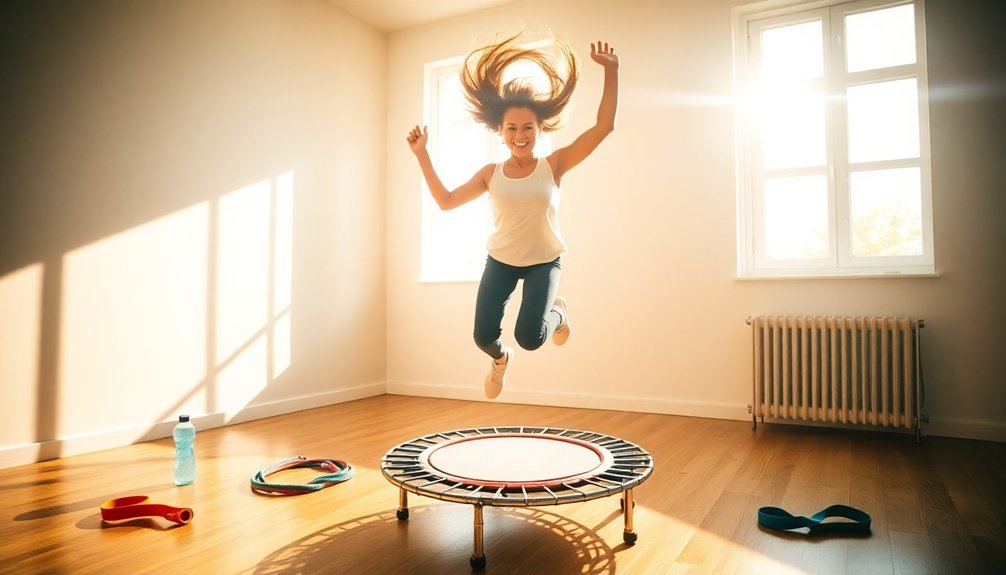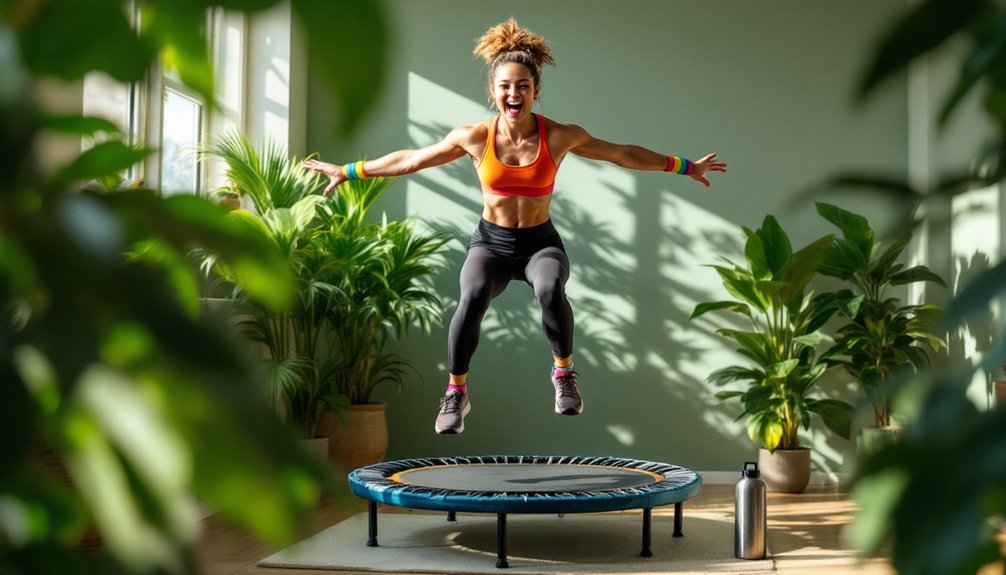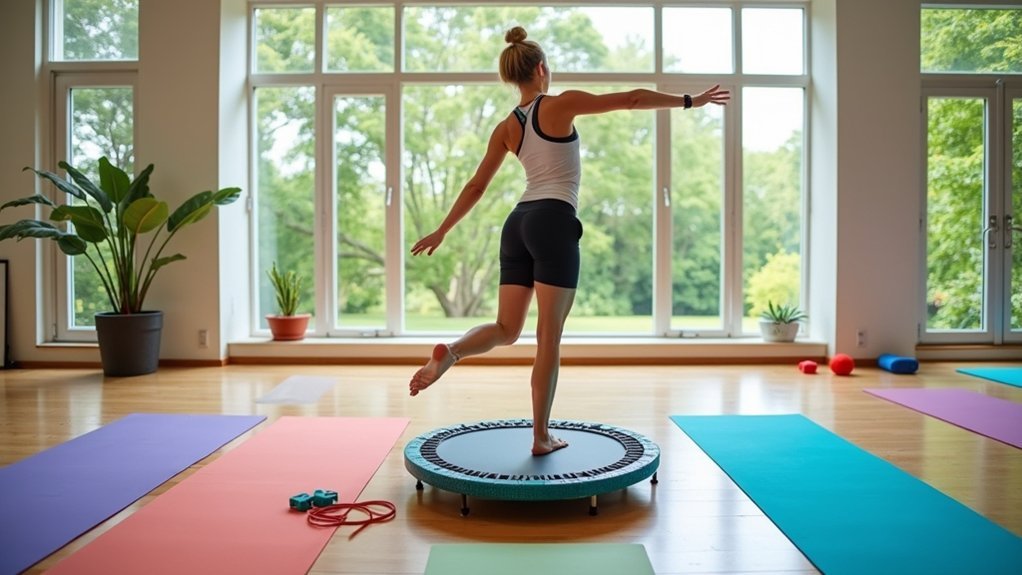Mini trampoline workouts transform your cardio routine by boosting heart rate to 79% of maximum while reducing joint impact by 80% compared to running. You'll burn 7-12 calories per minute with NASA research showing it's 68% more effective than jogging. The bouncing engages multiple muscle groups simultaneously while triggering mood-enhancing endorphins. Whether you're a beginner or fitness enthusiast, these low-impact sessions improve balance, coordination, and cardiovascular health with considerably less perceived exertion.
The Science Behind Mini Trampoline's Heart-Boosting Effects

While mini trampolines might seem like simple recreational equipment, they actually offer powerful cardiovascular benefits backed by scientific research.
When you bounce, your heart rate increases considerably, reaching approximately 79% of your maximum heart rate while consuming about 59% of your VO2max—meeting ACSM guidelines for cardiorespiratory improvement.
Unlike high-impact exercises, trampolining delivers these benefits without stressing your joints. Each bounce improves blood circulation and oxygen consumption while potentially lowering blood pressure and triglyceride levels.
You're effectively engaging in vigorous-intensity exercise that doesn't feel as demanding as traditional cardio. Participants in trampoline studies consistently reported an average RPE of 11.7, indicating they perceived the workout as light to moderate intensity despite the significant cardiovascular engagement.
The low-impact nature combined with high cardiovascular returns explains why many fitness experts now recommend mini trampolines for heart health—you're getting runner's benefits without runner's knees.
How Rebounding Protects Your Joints While Maximizing Cardio Benefits
You'll experience 80% less impact on your joints when rebounding compared to running on pavement, thanks to the mini-trampoline's shock-absorbing surface.
This joint protection doesn't compromise your workout intensity—you'll still burn calories comparable to running six miles per hour while feeling less perceived exertion.
The unique combination of impact absorption technology and full-body muscle engagement creates an ideal environment for getting your heart pumping without the joint pain typically associated with high-intensity cardio. The mini trampoline acts as a shock absorber, minimizing injury risks while still providing excellent cardiovascular benefits.
Impact Absorption Technology
Modern rebounders feature revolutionary impact absorption technology that transforms high-intensity cardio into a joint-friendly workout.
These mini trampolines use calibrated springs made from piano wire that absorb up to 87% of impact force, protecting your knees, hips, and ankles from stress.
You'll notice the difference in the mat materials too—durable, non-slip surfaces provide stability while distributing your weight evenly across the bouncing surface. The Pro Gym Rebounder specifically uses 36 muscle-shaped springs that provide optimal bounce while maintaining joint protection.
The high-gauge steel frames and padded spring covers add another layer of protection and comfort during intense sessions.
Unlike running on pavement, which hammers your joints, rebounding allows you to enjoy vigorous cardio while experiencing notably less impact.
This smart design means you can work out longer, recover faster, and maintain your routine without the joint pain associated with traditional high-impact exercises.
Joint-Safe Cardio Intensity
Unlike conventional high-impact cardio, rebounding delivers intense cardiovascular benefits without sacrificing joint health. The trampoline surface absorbs approximately 80% of the impact force that would normally stress your ankles, knees, and hips during ground exercises.
You'll experience considerable cardiovascular gains while your joints remain protected:
- Enhanced heart rate and circulation comparable to running at six miles per hour, but with significantly reduced perceived exertion
- Improved lung capacity through the natural deep breathing that accompanies the bouncing motion
- Complete muscle engagement that strengthens your core, legs, and glutes without overextending or straining connective tissues
This balanced approach makes rebounding accessible for all fitness levels and ages, allowing you to maintain intense workouts even with joint sensitivity. This makes rebounding an excellent option for those with osteoporosis who need to build bone density and strength without risking injury.
Bounce Without Pain
Traditional cardio options often force fitness enthusiasts to choose between effectiveness and joint protection, but rebounding eliminates this compromise entirely.
The trampoline's shock-absorbing surface reduces impact by up to 80% compared to running, while still delivering powerful cardiovascular benefits.
You'll strengthen your heart and improve circulation without the joint stress common in high-impact exercises. This makes rebounding ideal if you have chronic conditions or joint sensitivity but still want to boost your VO2 max and lower cholesterol levels. Rebounders with bungee cords provide smoother experiences than spring models, making workouts even gentler on sensitive joints.
For maximum safety, select a mini-trampoline with appropriate weight capacity and consider models with stability bars if needed.
Start with gentle bounces and gradually increase intensity. Proper footwear provides additional protection for your feet and ankles while you enjoy this joint-friendly, customizable workout.
Calorie-Burning Potential: Comparing Trampoline Workouts to Traditional Cardio
When you're choosing between exercise options, calorie-burning efficiency often plays a decisive role. Trampoline workouts aren't just fun—they're powerful calorie torchers that can rival or even surpass traditional cardio exercises.
Research indicates trampoline sessions can burn between 6.9-12.4 calories per minute, with high-intensity workouts delivering impressive results. A 150-pound person can expect to burn approximately 119 calories during a 30-minute mini trampoline workout.
Bounce your way to better fitness with trampoline workouts delivering a remarkable 6.9-12.4 calories burned per minute.
- NASA-Backed Efficiency: Studies show trampoline exercise is 68% more effective than jogging, offering superior cardiovascular benefits with considerably less impact.
- Variable Burn Rates: Your weight and intensity level matter—higher weights and more vigorous bouncing can burn up to 700 calories in a single class.
- Sustainable Activity: The trampoline absorbs 80% of impact, making it easier to maintain consistency without the joint stress of running.
Full-Body Engagement: Why Rebounding Delivers More Than Just Cardio

While calorie burning gets much of the attention, mini trampoline workouts offer a dimension of fitness that many exercises can't match: complete full-body engagement.
Unlike isolated movements, rebounding activates multiple muscle groups simultaneously, from your legs and core to your upper body.
You'll engage your entire muscular system with each bounce, especially when incorporating variations like twists, jumping jacks, and high knee punches.
Adding light weights intensifies this effect, creating a thorough strength training experience without excessive strain. Using light weights (1 to 3 lbs) is recommended to avoid strain while maintaining effectiveness throughout the workout.
What makes rebounding truly exceptional is how it strengthens not just surface muscles but also your deep stabilizing muscles and bones.
This thorough activation improves posture, enhances stability, and even supports pelvic floor health—benefits you simply won't find in many traditional cardio options.
Transforming Your Balance and Coordination Through Bouncing
Your mini trampoline workouts will transform your balance and coordination by engaging your proprioceptive system with each bounce.
As you stabilize yourself on the unstable surface, your core muscles activate continuously, strengthening your body's center and improving postural control. Scientific studies have shown that regular trampoline exercise produces significant balance control improvements across various age groups.
The constant adjustments you make while bouncing train your vestibular system and enhance spatial awareness, creating lasting improvements in your everyday movements.
Bounce for Better Balance
One of the most profound benefits of mini trampoline workouts lies in their remarkable ability to transform balance and coordination.
When you bounce regularly, your proprioception—your body's awareness of position—significantly improves as your vestibular system adapts to constant movement challenges.
Unlike high-impact exercises, trampoline workouts strengthen your balance systems while being gentle on your joints, making them perfect for all ages and fitness levels. The unique bungee suspension system enhances balance with every bounce you take, creating natural instability that your body must constantly adjust to.
- Your core muscles naturally engage with each bounce, creating a stronger foundation for everyday stability.
- The dynamic nature of rebounding trains your brain to process balance-related information more efficiently.
- These balance improvements translate directly to real-world benefits, including reduced fall risk and better coordination.
Scientific evidence confirms these benefits aren't just temporary—they create lasting neurological adaptations that enhance your overall stability.
Coordination Through Core Stability
Core stability serves as the essential foundation for enhanced coordination during mini trampoline workouts. As you bounce, your abdominals and lower back muscles continuously engage to maintain balance on the unstable surface, naturally strengthening your core with every movement.
The rhythmic bouncing on a mini trampoline challenges your body to make constant micro-adjustments, improving proprioception—your awareness of body position in space. Exercises like the off-set squat specifically target balance enhancement while simultaneously working your leg muscles.
When you perform exercises like twists and knee drives, you're training your neuromuscular connections while engaging muscles throughout your entire body.
These coordination benefits extend beyond your workout. The skills you develop—enhanced balance, agility, and body control—transfer directly to everyday activities and athletic performance.
Your body learns adaptive movement patterns that reduce injury risk while improving overall physical stability.
The Joy Factor: Why You'll Actually Look Forward to Trampoline Workouts

Why do so many fitness enthusiasts trade their treadmills for trampolines? Simply put: joy. Unlike traditional cardio that often feels like a chore, mini trampoline workouts create a genuine sense of happiness that keeps you coming back.
Your brain loves bouncing because:
- Natural mood boosters – Trampolining triggers endorphin release more effectively than many other exercises, creating that coveted "runner's high" without the joint impact.
- Perception shift – You'll burn significant calories while perceiving less exertion due to the fun factor.
- Mindful movement – The act of bouncing naturally pulls you into the present moment, creating a meditative experience that reduces stress.
Even short sessions can transform your mood while providing serious fitness benefits. The playful nature of trampolining makes it a unique alternative to traditional workouts, turning exercise from a tedious task into an enjoyable activity you'll actually look forward to.
Getting Started: Essential Equipment for Your Rebounding Journey
To start your rebounding journey, you'll need a high-quality mini trampoline with appropriate weight capacity and either metal springs or bungee cords depending on your preference for bounce and noise level. Bungee cord systems provide quieter workouts than metal springs while still delivering excellent bounce quality.
Look for essential safety features like stability bars, non-slip surfaces, and secure framework that won't wobble during intense movements.
Consider your available space, budget, and workout goals when selecting between compact 39" models for smaller areas or larger 44" frames that offer more jumping surface.
Basic Equipment Essentials
Selecting the right mini trampoline forms the foundation of an effective rebounding practice. When choosing your equipment, consider both your space constraints and fitness goals. Most beginners benefit from a circular or foldable model with a 39" or 44" frame, depending on your height and available room.
- Trampoline Type: Metal coil trampolines offer a firmer, more responsive bounce ideal for fast-paced workouts, while bungee models provide a gentler impact on joints and require more effort per bounce. JumpSport offers various firmness options ranging from soft to extra-firm bounce to accommodate different exercise preferences and fitness levels.
- Weight Capacity: Select a model with a weight limit that comfortably exceeds your own for safety and equipment longevity.
- Stability Features: For beginners, models with attached handles provide essential balance support, while grip socks prevent slipping during intense rebounding sessions.
Safety Features Matter
Safety goes hand-in-hand with selecting the right mini trampoline for your fitness journey. Look for models with stable arched-leg frames and proper weight capacity for your body type. Quality matters—don't compromise on this essential equipment.
Before each session, place your rebounder on a flat surface away from obstacles, ensuring ample clearance around it. Wear supportive shoes or grippy socks to prevent slipping, and always check for worn or damaged parts. Premium models like the JumpSport 39 support users up to 275 lbs weight, offering both stability and performance during your cardio sessions.
Consider trampolines with handlebar attachments if you're concerned about balance. Remember, only one person should use the trampoline at a time.
If you're new to rebounding, start with a gentle warm-up and focus on proper landing techniques to reduce joint impact. For those with pre-existing conditions, consult your doctor before beginning this exercise routine.
Progressive Mini Trampoline Routines for Beginners to Advanced Fitness Levels
Whether you're just starting your fitness journey or looking to challenge yourself further, mini trampoline workouts offer adaptable routines for every level.
From gentle bounces to intense cardio sessions, mini trampolines meet you exactly where your fitness level is.
Begin with basic bouncing and simple jumping jacks to develop your balance and confidence before progressing to more challenging exercises like twists and knees-to-chest movements.
- Beginner Level – Start with 5-10 minutes of basic bouncing and skiing motions to build foundational strength in your core and leg muscles.
- Intermediate Level – Incorporate jumping jacks and twists for 15-20 minutes to enhance coordination while engaging multiple muscle groups.
- Advanced Level – Challenge yourself with weighted accessories, choreographed routines, and increased workout duration to maximize caloric burn and cardiovascular benefits. Research shows trampoline workouts deliver similar energy expenditure to running at 6mph while feeling less strenuous.
As you advance, monitor your heart rate to verify you're pushing yourself appropriately while maintaining proper form.
Combining Strength Training With Rebounding for Maximum Results
Once you've established a solid rebounding foundation, amplifying your results becomes possible through the strategic combination of strength training with your mini trampoline workouts.
This powerful pairing engages multiple muscle groups while maintaining the joint-friendly benefits of low-impact exercise.
Try adding hand weights during bounces to involve your upper body, or alternate between rebounding intervals and strength moves like squats or lunges.
You'll experience improved muscle balance, enhanced cardiovascular function, and increased calorie burn compared to either exercise alone.
This integration particularly strengthens your core and lower body while improving balance and coordination.
For rehabilitation purposes, this combined approach offers exceptional benefits for bone density, insulin sensitivity, and post-injury recovery.
Whether you're a beginner or advanced athlete, you can tailor this combined workout to your specific fitness level.
How Mini Trampoline Workouts Complement Other Fitness Activities
Mini trampoline workouts serve as the perfect companion to virtually any fitness routine you've already established. They provide a revitalizing change of pace on your low-impact recovery days while still delivering cardiovascular benefits. Rebounding offers a full-body workout that effectively engages multiple muscle groups simultaneously.
You'll find rebounding particularly valuable when you need to protect your joints but don't want to sacrifice calorie burn or aerobic conditioning.
- Versatile Recovery Tool – Use rebounding on rest days from high-intensity workouts to maintain fitness momentum without overtaxing your body.
- Time-Efficient Alternative – Substitute a 10-minute rebounding session for a 30-minute run when you're pressed for time.
- Cross-Training Enhancer – Add mini trampoline exercises to improve balance and coordination that transfer to other sports and activities.
Real Success Stories: Transformations Through Consistent Rebounding
The proof of any fitness method lies in the real results people achieve, and rebounding success stories paint a compelling picture of transformation.
You'll find numerous accounts of individuals shedding significant weight—some even losing 50 pounds through dedicated rebounding practice.
Beyond weight loss, you'll discover stories highlighting improved cardiovascular health, enhanced balance, and increased bone density, particularly in vulnerable areas like the femur and spine.
Many rebounders report newfound energy and substantial improvements in muscle tone, especially in the legs, core, and pelvic floor. One rebounder experienced joint pain relief and lost 10 pounds in less than three months of consistent practice.
What makes these success stories particularly powerful is the psychological component. The enjoyable nature of rebounding keeps people motivated long-term, creating sustainable fitness habits.
The accessibility factor means you're more likely to stick with it, turning initial attempts into life-changing transformations.
Addressing Common Concerns About Mini Trampoline Safety and Effectiveness
Why do so many fitness enthusiasts hesitate before adding a mini trampoline to their workout arsenal? Often, it's due to misconceptions about safety and effectiveness. The truth is that mini trampolines provide exceptional low-impact cardio workouts while being considerably safer than their full-sized counterparts.
1. Safety considerations: While injuries can occur, proper setup with safety nets, regular maintenance, and adult supervision for children dramatically reduce risks. Mini trampolines offer less joint impact compared to traditional exercises like running.
Adults typically face minimal danger with proper technique.
2. Cardiovascular benefits: Research confirms that rebounding meets moderate to vigorous intensity standards, improving heart health and lowering resting heart rate over time.
3. Full-body advantages: Beyond cardio, you'll enhance balance, coordination, bone density, and mood – all while enjoying yourself more than during traditional workouts.
Frequently Asked Questions
Can Mini Trampolines Help With Lymphatic Drainage and Detoxification?
Yes, mini trampolines considerably help with lymphatic drainage and detoxification. When you bounce, you're activating your lymphatic valves up to 15 times more efficiently, helping your body naturally remove toxins through increased flow.
Are Mini Trampoline Workouts Suitable During Pregnancy or Postpartum Recovery?
During pregnancy, you shouldn't use mini trampolines due to fall risks and abdominal trauma concerns. However, they're excellent for postpartum recovery, offering low-impact exercise that strengthens your pelvic floor and core when you're ready.
How Long Do Mini Trampolines Typically Last Before Needing Replacement?
Your mini trampoline's lifespan varies—budget models last 2-3 years, mid-range 5-7 years, and high-end up to 10+ years. With proper maintenance, regular part replacement, and indoor storage, you'll extend its useful life considerably.
Can Rebounding Help With Specific Conditions Like Fibromyalgia or Arthritis?
Yes, rebounding can help with fibromyalgia and arthritis. You'll experience reduced joint stress, improved muscle strength, better mobility, and pain management. It's a gentle exercise that promotes healing while releasing stress-reducing endorphins.
Do Weather Conditions Affect Outdoor Mini Trampoline Performance and Safety?
Yes, rain makes mats slippery, heat degrades materials, and wind creates dangerous instability. You'll need to anchor your mini trampoline securely outdoors and consider using protective covers during harsh weather conditions.
In Summary
You'll transform your fitness routine with a mini trampoline's unique benefits. You're getting exceptional cardio while protecting your joints, burning serious calories, and improving balance. Don't overlook how rebounding engages your entire body in ways traditional workouts can't match. Whether you're a fitness beginner or seasoned athlete, adding consistent bouncing sessions will revolutionize how you feel, move, and perform in all your activities.





Leave a Reply